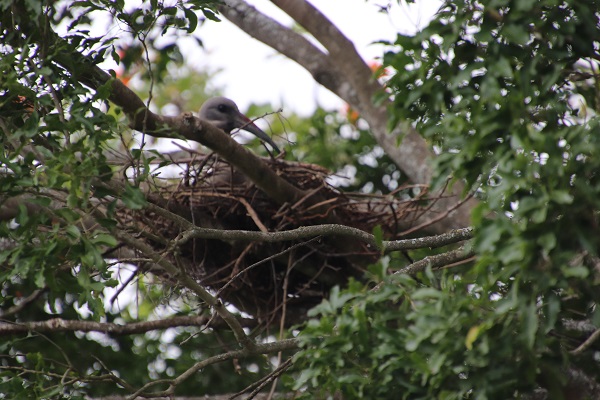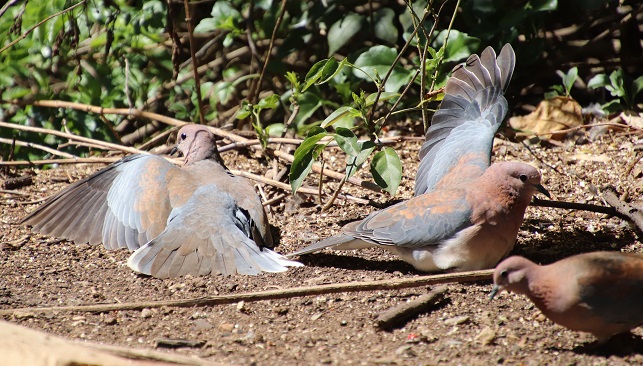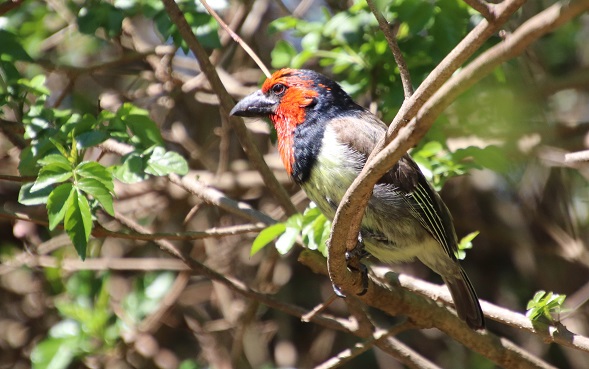There has been a lot of avian activity in the garden during October. Green Woodhoopoes have made regular forays to seek food in the dry wood of some of the trees that are succumbing to the drought. Their cheerful cackles are sure to uplift one’s spirits. Streaky-headed Canaries have become regular visitors – usually during the quieter part of the afternoons. Then, the three Common Fiscals vie with each other to get to the container of ‘special food’ I put on the table when I am outside. Meneer is still the only one to perch next to me to help itself or to take food from my hand though. Hadeda Ibises remind everyone in the neighbourhood at least half an hour before sunrise that a new day is dawning. One of their number sits patiently on her nest above the wash line for much of every day. The basket-shaped nest is about four metres above the ground and has been constructed from sturdy sticks and smaller twigs. These will have been gathered by the male.
White-rumped Swifts wasted no time to start a family once they had arrived earlier this month. This was easy for them as they are again using the cosy, well-built mud nest outside our front door, which they usurped from the Lesser-striped Swallows a few years ago. The latter took a few days rest and are currently rebuilding their mud nest under the eaves at the back of our house that broke soon after their departure at the end of last summer. Love is definitely in the air, and the Cape Crows are no exception. I watched a pair of them courting in the Erythrina for well over an hour. I don’t know where they have chosen to nest, but we hear the two of them calling to each other throughout most of each day now.
The cuckoos are back in force too: Red-chested Cuckoo (widely known here as the Piet-my-vrou), Diederik Cuckoo, as well as Klaas’s Cuckoo fill the air with cheerful calls – the mournful call of the Black Cuckoo-shrike provides a sharp contrast. A Pin-tailed Whydah in full breeding regalia visits now and then. It has obviously chosen a territory somewhere else for it drops in for food and I have not seen any of its wives yet. Laughing Doves regularly sun themselves in the sandy area of the garden.
As some brighter colour is needed, here is a Black-collared Barbet waiting to take its turn at the feeding tray.
My bird list for this month:
African Green Pigeon
Amethyst Sunbird
Bar-throated Apalis
Black-collared Barbet
Black Cuckoo-Shrike
Black-eyed (Dark-capped) Bulbul
Black-headed Oriole
Bronze Mannikin
Cape Crow
Cape Robin-Chat
Cape Turtle Dove
Cape Wagtail
Cape Weaver
Cape White-eye
Cardinal Woodpecker
Cattle Egret
Common Fiscal
Common Starling
Diederik Cuckoo
Fork-tailed Drongo
Greater Double-collared Sunbird
Green Woodhoopoe
Grey-headed Sparrow
Hadeda Ibis
Klaas’ Cuckoo
Knysna Turaco
Laughing Dove
Lesser-striped Swallow
Olive Thrush
Pied Crow
Pin-tailed Whydah
Red-chested Cuckoo
Red-eyed Dove
Red-throated Wryneck
Red-winged Starling
Sacred Ibis
Southern Boubou
Southern Masked Weaver
Speckled Mousebird
Speckled Pigeon
Streaky-headed Seedeater
Village Weaver
White-rumped Swift





Lovely Anne! Such a joy to have so many birds in your garden! xxx
LikeLiked by 1 person
The birds provide me with great joy and never-ending interest, thank you.
LikeLiked by 2 people
Your birds are incredible. Love seeing your lists and pictures of course.
LikeLiked by 1 person
I am so pleased that you do.
LikeLike
Another impressive garden list, Anne. Lovely photographs
LikeLiked by 1 person
Thank you very much!
LikeLike
Your photographs and prose make excellent companions
LikeLiked by 1 person
Thank you for your kind comment, Derrick.
LikeLiked by 1 person
What an impressive list! Lovely photos. Such a lot to learn from your posts.
LikeLiked by 1 person
I am pleased you find them interesting.
LikeLiked by 1 person
Hail, Spring! So much beautiful, fluttering life for you to see. Love this post.
LikeLike
Thank you, Laurie. You have boosted my spirits 🙂
LikeLiked by 1 person
Quite a list of birds Anne! Love the photos!
LikeLike
Thank you very much; our garden has enough variety of habitats to encourage a number of birds to visit daily.
LikeLike
That is amazing. We get quite a different lot of birds here
LikeLiked by 1 person
Pragtig, ek lief die twee wat lyk of hulle vlerksleep.
LikeLike
Dankie, daar is altyd iets interessant om te sien.
LikeLiked by 1 person
You do well to record all your sightings. I don’t think that we get enough variety to make it worthwhile for me to do the same.
LikeLike
It is a useful way of keeping track of seasonal changes. Some birds that used to be transient have become regulars, while others have started to nest in the garden more regularly. Yet others we see less often as the habitat changes with time.
LikeLiked by 1 person
Good science.
LikeLiked by 1 person
I love the soft coloring of the Laughing Doves, so beautiful. (Makes me want to paint something those colors. 🙂 )
Breeding season is such a optimistic time of year – new life all around!
LikeLike
The colours on the Laughing Doves are subtle and make a beautiful combination. It is a good feeling to see so much ‘new life’ on the wing and in the trees – even though there is still no rain in the long-term forecast.
LikeLike
That’s a good list for a garden – interesting that even Cape Crows come to your garden – I have only ever seen them out in the countryside
LikeLike
In previous decades, the Cape Crows have mostly been seen either on the outskirts of town – especially in the vicinity of our grossly mismanaged municipal dump – or flying over the garden. This season is the first that I have observed one regularly perching on the top of the cypress tree next door and the first time I have seen a pair of them courting in the Erythrina tree in our garden. It / they has been around daily now for the past three weeks, if not in the aforementioned trees then in the Natal fig tree. I have not yet observed them on the ground.
LikeLiked by 2 people
An impressive list. Your garden sounds very lively! I’m glad the fiscals are regular visitors. The ibis is one large mama bird 😊. How wide is its nest?
LikeLiked by 1 person
Given that the Hadeda Ibis is about 76 cm (30 inches) long, the nest is rather large.
LikeLiked by 2 people
Nice to see some of our summer regulars pop into your list, Anne! And yet again it is a very impressive list indeed!
Having a hadeda family above your washing line must make drying the clothes a bit of a gamble? 😉
LikeLiked by 1 person
The washing line … I know exactly where NOT to peg any garment!
LikeLiked by 2 people